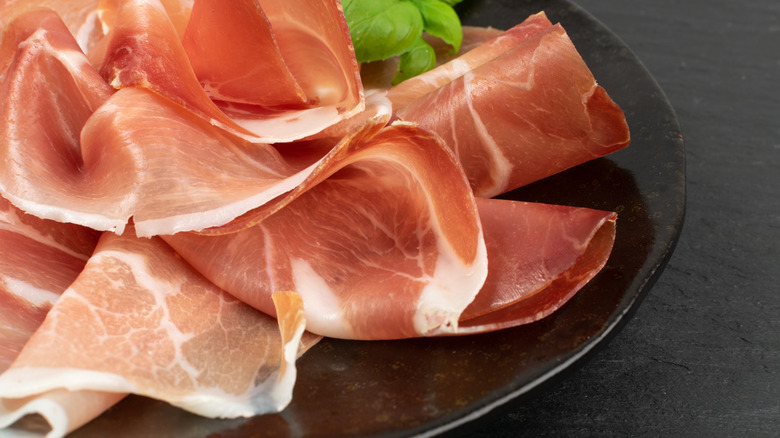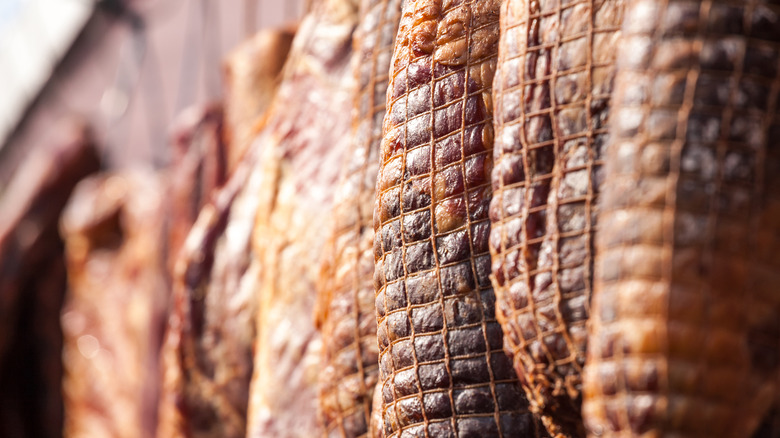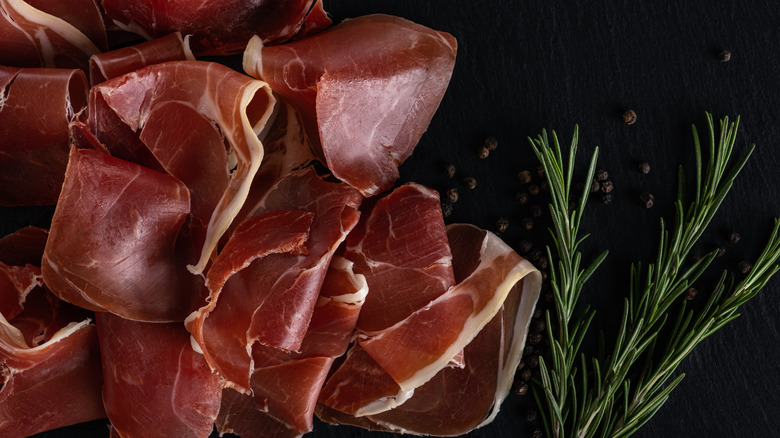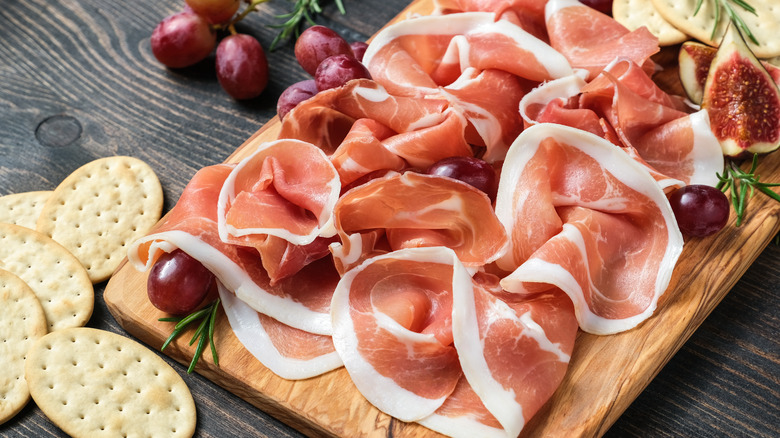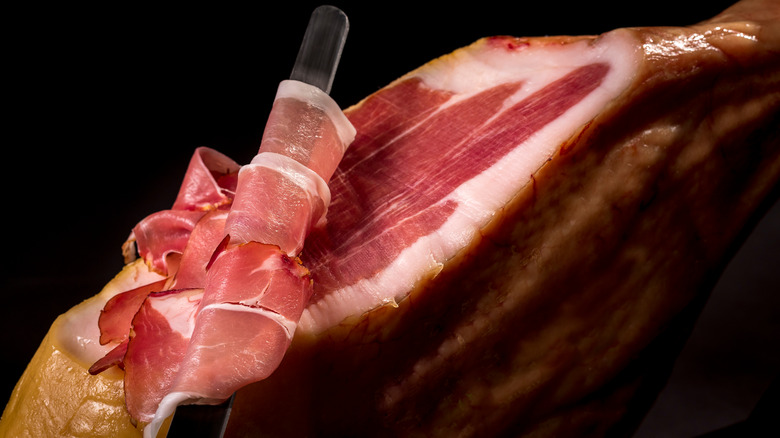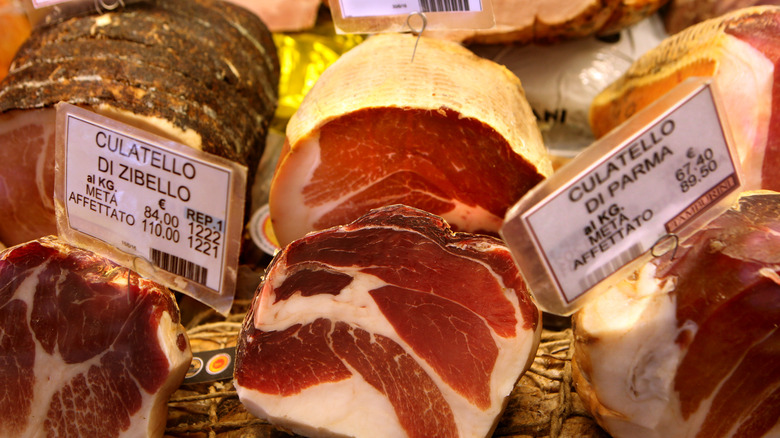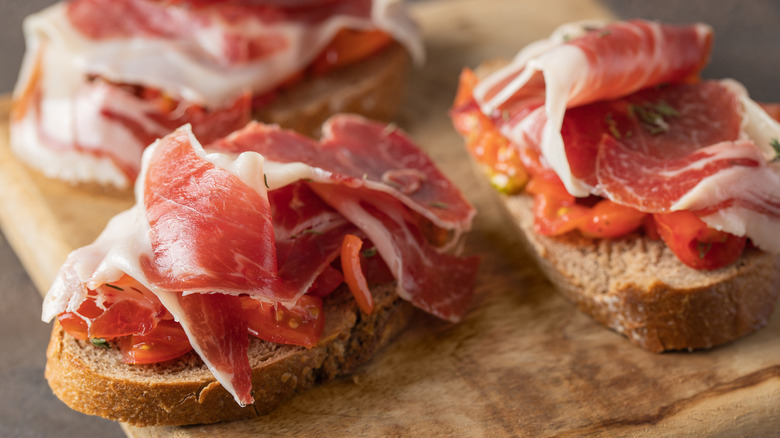What Is Prosciutto And Is It Safe To Eat?
The charcuterie board has maintained its popularity for years and comes topped with a variety of delicious options. Creamy wedges of French Brie and shaved parmesan accompanied by fig spread, sweet honey, and an assortment of seeded crackers give you a solid start when you make your own version of this classic spread. While these items start you off right, no charcuterie spread comes complete without some form of pink, paper-thin, fatty ribbons of Italian ham.
Cured meats are diverse and plenty, and you've probably had your fair share without knowing your capicola from your pancetta. If you're looking to expand your knowledge of charcuterie, you can't go wrong with prosciutto. This beloved Italian meat ranks as one of the most popular types of salumi in the world (via Eataly). Salt-cured and characterized by delicate slices that practically melt in your mouth, it's often eaten alone or as an accompaniment to your favorite finger food. However it's eaten, prosciutto guarantees to take your meal from good to great.
What is prosciutto?
Prosciutto is ham that is cured instead of cooked. The word literally translates to ham in Italian, but this isn't your average slice of pork from the deli. The process of preparing prosciutto is a little more complex. It all starts with a very specific cut of meat — high-quality hind legs of a pig, per MasterClass. The leg is covered in a heavy coat of salt and left to cure for a week before it is either salted again or washed, seasoned, and then dry-aged, where it is stored in a temperature-controlled area for anywhere from 14 to 36 months, according to Eataly.
The salting and drying process gives prosciutto a distinct sweet and savory taste. When served, the ham is sliced almost impossibly thin, making it ideal for rolling up on a charcuterie board or layering onto a cracker or sandwich.
What does prosciutto taste like?
Like many ham products, prosciutto is salty and fatty in the best way possible. The months-to-year-long preparation of the pig leg leaves it packed with flavor, but also creates a tough, dense, and dry texture (via Spoon University). Prosciutto is characterized by its remarkably thin slices — if it were cut any thicker, the meat would hold a completely different texture that wouldn't be pleasant to chew. Prosciutto ribbons are somewhere between a delicate pink and a salmon-red color, broken up and bordered by white streaks of fat, according to Eataly.
In terms of flavor, prosciutto is first and foremost salty thanks to its curing method. While it contains a savory bite, the palate can also detect semi-sweet undertones. Some recipes include additional flavors of black pepper, garlic, and rosemary, making for a more robust, complex flavor profile. These aromatic notes perfectly complement the meat's paper-thin texture.
How is prosciutto made and is it safe to eat?
The process of curing meat might seem a little archaic on the surface, but it's tried, true, and time-tested. It's completely safe, and one of the oldest ways to preserve and prepare animal cuts. According to Walden Labs, humans have been preparing meat in this fashion since at least 40,000 B.C.
Curing prosciutto takes over a year. The process enhances the flavor and simultaneously wards off any harmful bacteria that could make their way into the exposed tissue, per Parma Crown. Heavily coating a piece of meat with salt draws blood and moisture out of the tissue and out onto the surface of the cut, where it then evaporates, according to BBC. This meat-drying process and lack of water make the tissue uninhabitable for harmful organisms. With cuts of meat as large as a pig's hind leg, the process of successfully drawing out moisture takes some time, which only concentrates the flavor as the months go on. While prosciutto is not cooked, it's cured and dried, meaning it's safe to eat.
Prosciutto crudo vs. prosciutto cotto
Several regional versions of prosciutto exist, like prosciutto di Parma and prosciutto Toscano, per Bricco Salumeria. These styles vary in type of pig used as well as seasonings, but prosciutto crudo and prosciutto cotto are the two basic terms you should know when it comes to preparation methodology, according to Eataly.
The cured and dry-aged form of the protein is recognized as prosciutto crudo, the traditional form of meat that is never cooked and sliced into thin ribbons. Prosciutto cotto, on the other hand, is slow-cooked at a controlled temperature. It is lighter in flavor and color in comparison to its dry-aged counterpart and often cut into moist slices when served. Crudo translates to raw, whereas cotto means cooked. Both have their place in Italian fare, whether that's on a panini or lining a charcuterie board — what you choose simply depends on personal taste.
Where can you buy prosciutto?
According to Parma Crown, varieties of pre-sliced portions of prosciutto are often sold in packages at a grocery store's deli. You can also find brands of prosciutto in the grocery sections. Target carries the product and you can even add the item to your online grocery cart for a quicker, easier shopping experience.
If you love tracking down local ingredients, an Italian deli or specialty food store near you should carry the meat. They'll likely have more than just one type of prosciutto, and some delis may even allow you to taste test samples before selecting a product to take home. There's also just something about watching the meat being sliced directly from the cut behind the counter, knowing that it will soon go from deli to plate. Either way, you can't go wrong when you want to get your hands on this delectable product.
Nutritional information about prosciutto
The nutritional contents of prosciutto depend on the specific type, as well as how much is eaten. Boar's Head prosciutto di Parma contains 60 calories per serving, with 30 of said calories from fat. One portion only contains 5% of your daily recommended fat intake. Additionally, the same thin slice of prosciutto di Parma yields 8 grams of protein, 16% of your daily intake. The sodium content is high at 660 milligrams — 27% of your daily recommended intake in one serving of the meat. The product also contains trace amounts of iron and potassium.
When you need to construct the perfect charcuterie board, you can't go wrong with this classic Italian protein. This meat can imbue any meal with a bold, new flavor, and guarantees to take any dish to a whole new level.
